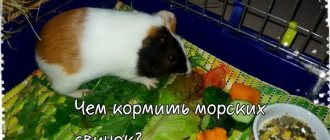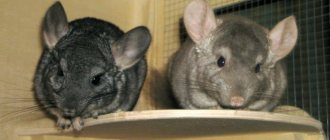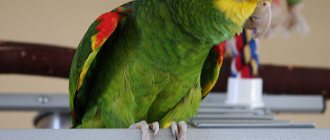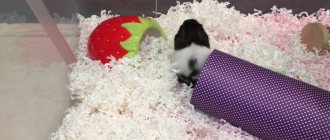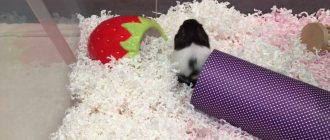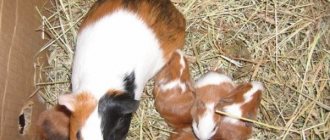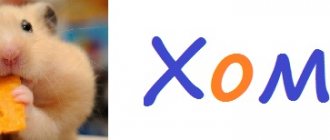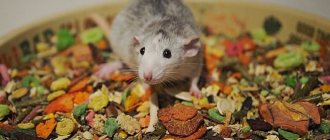| Place | Name | Characteristics in the rating |
| TOP 10 best food for guinea pigs |
| 1 | Versele-Laga Complete Cavia | The best pelleted food for adults |
| 2 | JR Classic Feast | The largest volume. Prevention of excess weight |
| 3 | Fiory Micropills Baby Guinea Pigs | The best diet for young animals from one month to six months |
| 4 | Vitakraft Premium Menu Vital | Popular pet product with yucca extract against unpleasant odor |
| 5 | Chica Bio | Universal grain-free assortment for animals of all ages |
| 6 | Versele-Laga Crispy Muesli Guinea Pigs | Multi-colored muesli for all types of pet rodents |
| 7 | Fiory Sticks | The best treat adapted for guinea pigs |
| 8 | Vitakraft Vita Verde Meadow hay | Natural meadow complex with plantain and clover |
| 9 | Animal Zoom World | Russian grain mixture with the best price-quality ratio |
| 10 | Little One Guinea Pigs | The most inexpensive combination product |
Cute and good-natured guinea pigs are domesticated rodents and, contrary to their name, have nothing to do with either the sea or pigs. These miniature furry animals have a number of advantages over other pets. They look funny, love human company, do not show aggression, and their color and coat structure delights with their diversity. In order for your pet to live a long and happy life, it is necessary to properly care for it, and first of all, feed it properly. The basis of the diet of guinea pigs is cereals and plant foods, but not all cereals, vegetables and fruits are suitable for the delicate stomach of these babies, and some “human” delicacies can even cause a great health risk.
For those who are not well versed in the nuances of proper nutrition for ornamental rodents, it is better to trust the professionals and raise their pet on industrial food. In finished products, the balance between vitamins and microelements is optimally maintained, and the varied composition allows you to take into account all the needs to strengthen the immune system and maintain a beautiful appearance.
Feed composition. What to look for
The guinea pig is a true vegetarian, with a capricious digestive system. There are a number of ingredients that are unacceptable in their diet:
- molasses or sugar
- animal proteins (bone and fish meal are not digestible)
- whole grains of corn and legumes (if they are too dry, they can get stuck between the teeth. This can cause refusal of food, and further death of the animal).
Acceptable ingredients:
- cereals (the best option is in the form of flakes or puffed grains)
- herbal granules
- dried leaves
- flowers and herbs
- twigs and bark of some trees
- dried vegetables.
The presence of peanuts and sunflower seeds is also acceptable. But due to the high fat content, it must be kept to a minimum. The content of berries and dried fruits should also be minimal. They are sources of not only vitamins and minerals, but also sugars, which, in turn, can trigger the development of diabetes.
The best treats for guinea pigs
Once a week, you can arrange a belly celebration for your pet, and treats in the form of sticks or pads will help with this.
They consist of fruits, nuts and other goodies. They should not be abused so as not to cause obesity and increased blood sugar in the rodent.
Titbit Tartlets
4.8
★★★★★
editorial assessment
90%
buyers recommend this product
Baskets made of unleavened dough with a delicious filling of pumpkin and pineapple will please any rodent. The tartlet base consists of first grade flour, corn, potatoes and oats.
The special structure helps clean the pig's teeth from plaque and strengthen the gums. Pumpkin saturates the body with carotene and beneficial minerals, and pineapple is rich in sucrose and ascorbic acid. There are 8 such tartlets in the box.
Pros:
- Original form;
- Tasty and healthy filling;
- Contains carotene, as well as a lot of micro- and macroelements;
- The hard dough basket strengthens and cleans teeth;
- Suitable for pigs of any age;
- There are 8 tartlets in a package.
Minuses:
- Lots of carbohydrates and sugar;
- The filling falls out.
The unusual presentation is not fully thought out; in some baskets, the middle with tasty treats falls out. You should not give more than one treat at a time due to the high carbohydrate content (60%) and only 6% fiber.
Review of popular foods
| Name | Manufacturer | Average cost RUR/kg |
| JR Farm Classic | Germany | 335 |
| Menu Vital | Vitakraft, Germany | 450 |
| Cavia Complete | Versele-Laga, Belgium | 660 |
| Chica-bio | Russia | 400 |
| Littleone Green Valley | Mealberry, (Russia-Germany) | 300 |
| Karma | Vitapol, Poland | 300 |
| Littleone Guenea Pigs | Mealberry, (Russia-Germany) | 240 |
| Sultan | Russia | 175 |
| Animals | Zoomir, Russia | 160 |
| Baka High quality | Russia | 140 |
| Dusya | Zoomir, Russia | 130 |
All foods presented in the review are enriched with vitamins and minerals necessary for complete and proper nutrition. All formulations contain dried vegetables. Let's consider how they differ from each other, what are the advantages and disadvantages.
Feeding the Cubs
It often happens that after giving birth, the female does not have milk. Then the question arises of how to properly feed newborn piglets. In this case, the owner must take on the mission of a caring mother. For this he will need:
- insulin syringe (without needle) or squirrel brush;
- cream with 10% fat content;
- prebiotic Linex;
- kitchen scales for monitoring baby's weight.
Every hour during the day, you need to give the piglet up to 1 ml of cream through a syringe without a needle, sometimes at night - every 2 hours. You need to make sure that the baby licks and swallows the food. You can alternately add 1/10 of a crushed Linex capsule or a quarter of the litter of a healthy pig to the cream. After a week, you need to add a little ground granules of food or baby porridge (dairy-free) to the cream.
If the mother pig does not have milk, the baby is fed cream from a small syringe.
Instead of a syringe, you can use a brush: dip it in cream, give it to the baby’s mouth and pull it back. This is how newborn piglets develop a sucking reflex.
After feeding, the cub must go to the toilet; to do this, you need to very carefully massage its anus with a damp cotton swab
From the very first days, you can give babies a bowl with an apple, rolled oats, carrots, hay, granules - let them learn to chew. But they should be fed cream until they are 3-5 weeks old.
So, for the full development of a guinea pig, it is important that all nutrition components are selected correctly. If you follow the simple rules of caring for these cute rodents, you will be rewarded with excellent health, affection and love for your pet.
- What to feed the land and red-eared turtles
- What do turtles eat: nutritional features
JR Farm Classic
Treat as a combination food for guinea pigs.
Advantages:
- fiber content -15.6%
- a variety of herbs that are included in the animals’ natural diet and help reduce the likelihood of weight gain and healthy digestion
- cereals and legumes, aerated and in the form of flakes
- natural sources of vitamin C – parsley and clover
Flaws:
- Herbal granules in the composition are not to the taste of all pigs
- contains whole corn kernels
Recommendations for the selection and use of dry food
When choosing, it is necessary to take into account the age and breed of the guinea pig, its state of health and the time of year. For females, an additional criterion is pregnancy and lactation.
- The pet store must be verified. It is better if the establishment provides a free consultation with a veterinarian.
- During the harvest season, the feed should contain a minimum of dried fruits and vegetables. During this period, it is necessary to give your pet fresh fruits.
- Foods high in sugar, nuts, corn, dried fruits, beet pulp and animal proteins should not be fed every day. You can set aside special “holiday” days for this delicacy.
- A sick animal needs special care. Your veterinarian will help you choose food for your pet.
- It is recommended to stock up on two or more types of food, then use the behavior and well-being of the animals to understand which is better. Feeds can also be mixed with each other.
- It is better to give preference to a mixture that consists of granules of a natural color (without dyes) and has a herbal smell.
- Dry food should not make up your pet's entire diet.
- Dry food should be kept in a cool place protected from light.
Animals
| Advantages | Flaws |
|
|
What else can you give?
In order for a guinea pig to wear down its teeth, it must be given tree branches to chew on. Branches should be collected away from the road. Before feeding, the branches must be cleared of dirt and washed under running hot water.
Which tree branches can be given:
- Birches;
- Linden trees;
- And you;
- Apple trees;
- Pears;
- Cherries;
- Rowan trees.
In addition to food, the animal needs vitamins. The kewi's body is designed in such a way that it cannot obtain vitamin C from regular food. A lack of this vitamin leads to various diseases, so additional feeding is necessary.
One adult should be given 5-15 mg of ascorbic acid daily. The vitamin can be dissolved in a glass of water and poured into a drinking bowl.
Baka High quality
– the best dry food from the Vaka brand line, which has received the maximum number of positive customer reviews.
Pros:
- enriched with probiotic,
- eaten completely, without waste,
- price.
Minuses:
- predominance of cereal crops,
- Contains bone meal, yeast, and salt.
How many times a day to feed
The first thing to remember is that the rodent does not have to immediately eat the entire portion that the owner gives him; he can finish it later, which is quite normal. Therefore, bowls of water and food are always available. But you need to feed her 2-3 times a day.
It is correct to feed succulent food in the first half of the day; in the second half, the emphasis is on dry food. If a pet receives two meals a day, then at one time he needs 0.5 tablespoon of dry food, with three meals a day, 1/3 tablespoon.
When a rodent eats the main portion of food, it switches to dry grass; its body is designed in such a way that it constantly needs food, otherwise the intestines stop. Therefore, it is strictly forbidden for him to go hungry, and he simply must not remain without food.
Menu Vital
– leader in the line of feed from the German company Vitakraft. This manufacturer's product range includes both basic products and premium foods: combined, granulated, and even for animals with sensitive digestion.
Advantages:
- enriched with vitamin C, linoleic acid, zinc and biotin, which has a positive effect on the body’s condition
- contains Yucca Schidigera extract - a source of vitamins C and B, as well as minerals: calcium, iron, magnesium and phosphorus. It is added to animal feed to strengthen the immune system and prevent inflammatory processes in the digestive system.
- different packaging
Flaws:
- high percentage of grain content
- presence of food coloring
Diet structure
Guinea pigs are non-productive animals, so rationing of feeding does not aim to ensure high weight gain. The approximate structure of the diet of an adult Guinea pig is presented in grams:
- Concentrated feed –55.
- Rough (hay, preferably clover) – 60.
- Juicy (grass, root vegetables) – 500.
However, most guinea pig lovers live in city apartments and keep them for decorative purposes. Consequently, it is difficult to provide the diet structure proposed above, so it is more correct to talk about the main food and treats. A peculiarity of the Guinea pig's digestion is the increased need for vitamins B, K, as well as ascorbic acid. They are usually added to specialized feed mixtures, and some of them come with treats.
Guinea pigs, like rabbits, resort to repeated digestion - coprophagy. They eat night feces. The microflora of the large intestine synthesizes vitamins K and B, but their absorption from the caudal part of the alimentary tract is low. In addition, primary feces contain underdigested proteins, fiber, and complex carbohydrates. They are more fully absorbed when re-entered into the alimentary tract. Therefore, you should not panic when watching your pet eat its own feces. This is normal for a Guinea Pig.
Littleone Guenea Pigs
| Advantages | Flaws |
|
|
You can buy it here.
The best pelleted foods
Pressed products are found among all types of food for pigs, but there are separate fees for the main diet.
Granules are good because they contain all the necessary components, help grind teeth, but do not crumble like grains and do not create debris in the cage.
Dajana Exclusive Country Mix
4.9
★★★★★
editorial assessment
91%
buyers recommend this product
Complete food suitable for adults. It is made using cold extrusion technology, which preserves all nutrients and vitamins. The basis is meadow hay, wheat, bran, yucca, rosemary, sunflower, rose hips and lemon balm.
The granules are held together by omega-3 fats (from flax seeds), apple and carrot pulp. Brewer's yeast is used to increase appetite and assimilate ingredients.
Pros:
- Contains fiber and protein;
- Strengthens the immune system;
- Helps with grinding teeth;
- Helps improve the pet's appearance;
- The composition includes a probiotic – inulin;
- Pleasant taste and aroma.
Minuses:
- Yeast included;
- Dye used.
Yucca extract relieves bloating, normalizes the digestive tract and reduces unpleasant odor from your pet. There are two types of packaging to choose from: 500 and 1500 g.
JR Farm Grainies Complete
4.8
★★★★★
editorial assessment
87%
buyers recommend this product
Economical and relatively inexpensive food is suitable for pigs of all ages. The main ingredient is meadow grass, and as an addition there are pea and bean flakes, flax seeds, caraway seeds, cubes of apples, carrots and beets.
The mixture contains fennel, which relieves bloating and intestinal colic, as well as chamomile, which is responsible for resisting diseases. Hard granules imitate the density of bush branches and help clean and grind teeth.
Pros:
- Large packaging;
- The contents are clearly visible in a transparent bag;
- High-quality raw materials;
- Pleasant herbal smell;
- Chamomile and fennel relieve irritation in the intestines;
- Suitable for pets of all ages;
- Lots of fiber, minerals and ash.
Minuses:
- Inconvenient package;
- It crumbles a lot and has a chemical smell.
It is impossible to constantly feed pigs with dry formula. It is necessary to introduce fresh vegetables, herbs and other components. The packaging is quite large - 1350 g, so it is consumed slowly.
Littleone Green Valley (or Green Valley)
– grain-free food containing 60 types of herbs, with the addition of fruits, berries and seeds
| Advantages | Flaws |
|
|
Rules for storing hay at home
Almost all pet stores sell hay packaged in plastic bags. After the expiration date, you risk purchasing a rotten mixture.
Rules for storing hay at home:
- Regardless of whether you bought hay or prepared it yourself, store the mixture only in open form.
- The humidity in the room where hay is stored should not exceed 40% in summer and 50% in winter.
- Turn and loosen the hay regularly to allow it to “breathe.”
If storage rules are violated, dry grass begins to rot. At first, a barely noticeable, sweetish odor appears. Afterwards the mixture begins to heat up and rot. As hay rots, mold may form on the hay.
Sultan (Sultan)
| Advantages | Flaws |
|
|
What to do if your pig refuses to eat hay
The owner should be concerned if the pig refuses to eat hay. There are many possible reasons, but the most common ones are:
- Stale or rotten hay.
- The presence of poisonous herbs in the mixture.
- Problems in the gastrointestinal tract.
If your pet appears lethargic or weak while refusing hay, contact your veterinarian immediately. All diseases and dangerous conditions in guinea pigs develop rapidly, so delay can cost the pet’s life.
Karma
| Advantages | Flaws |
|
|
Grain nutrition scheme
In practice, guinea pig breeders choose one of two ways to feed their pets:
- grain;
- grain-free.
The grain-based method of nutrition involves the use of ready-made store-bought mixtures: grain or granulated. High-quality products from trusted manufacturers contain a rich set of minerals and other substances vital for the animal. Of course, such food should not constitute the entire daily diet of the pig, but only about 20%. The fruit and vegetable share is also 20%. Another 10% is greens, the rest is hay.
Attention! Good food is not cheap. Cheap analogues are made using simplified technology
They are useless or even harmful to the pig.
Important nuances in this matter:
- Dry food is good for a rodent's teeth, but hard on the stomach. Give it no more than 1 tbsp. l. per day, together with juicy greens or vegetables.
- Dry mixtures are not suitable for dramatically expanding the diet. Introduce them gradually, with 0.5 tsp. for one meal.
- This method of eating is characterized by increased calorie content. It must be combined with the pet's active lifestyle.
Cavia Complete
– the most popular product from Versele-Laga. This is granular food.
| Advantages | Flaws |
|
|
What not to feed
There are foods that are prohibited for guinea pigs, and it is worth saying that this list is quite long.
So, the prohibited ones include:
| Cereals and potatoes | Horseradish, radish, garlic |
| Dairy products, including cream, milk, cottage cheese | Burdock, sorrel, spinach |
| Smoked meats and various pickles | Any inflorescences, chestnuts, mushrooms |
| Winter products - tomatoes, cucumbers, watermelons | Pasta, bakery products |
| Confectionery | Salad mustard, green onions |
| Fish, eggs, meat | Sugar, table salt, sweet tea |
It is also worth knowing that branches of trees such as rowan, hornbeam, buckthorn, pine, oak, larch, elm, spruce, and willow are prohibited. Since you simply cannot do without wood, shoots of hazel, apple, cherry, plum, gooseberry (be careful, without thorns), apricot, hawthorn, blueberry, and pear are recommended.
Chica-bio
– premium grain-free mixture. Ideal for juveniles and lactating females. It contains only herbal granules, hay, twigs, vegetables, and fruits.
| Advantages | Flaws |
|
|
List of approved products
The diet of guinea pigs is based on foods such as vegetables, fruits, berries, garden and meadow greens, sunflower seeds, seeds, twigs of trees and shrubs.
Healthy and safe food for guinea pigs:
- Vegetables - cucumber, carrots, beets, pumpkin, fennel, zucchini, turnips, parsnips and celery in tubers. In small quantities you can treat your pet to bell peppers, tomatoes, artichokes, cauliflower, rutabaga, and Jerusalem artichoke.
- Fruits – seedless grapes, plums, apples, pears. Bananas, peaches, apricots, watermelon, melon, kiwi, pineapples, oranges and tangerines are served in small quantities.
- Berries - currants, raspberries, blueberries, cherries, sweet cherries, strawberries. In limited quantities - gooseberries, sea buckthorn, blackberries, cranberries, rowan.
- Garden greens - lettuce leaves, dill, celery, sprouted cereal grains, carrot tops, beets, corn cobs. In limited quantities - cilantro, spinach, parsley.
- Meadow greens - nettle, clover, yarrow, alfalfa, plantain, sage, echinacea, burdock, chamomile. Milk thistle, coltsfoot, dandelion, St. John's wort, wormwood, and fireweed are served in small quantities.
- Flax seeds are useful. In limited quantities - sesame seeds, dill, pumpkin and sunflower seeds.
- Useful branches of bushes and trees - birch, mulberry, hazel, pear, raspberry, ash, hawthorn, blueberry, maple and cherry plum. Sometimes you can pamper your pet with branches of chestnut, cherry, aspen, apricot, cherry, willow, poplar and rowan.
- It is not often that a rodent can be fed green peas and asparagus in small quantities.
Dusya
- another product of the Zoomir company. In composition, it is not much different from Zverushka’s food. But, according to reviews from animal owners, it is much better eaten.
| Advantages | Flaws |
|
|
What are the consequences of violating the nutritional rules?
According to statistics, pigs most often die due to intestinal disorders. With improper feeding, the microbial balance in the digestive tube is disrupted, the breakdown of cellulose is difficult, food is not properly digested, and death occurs from intoxication with metabolic products
This is why it is so important to monitor your diet and feeding regimen.
Feed must be of good quality and fresh, it must smell good and have no signs of spoilage or mold damage.
It is important that products are stored in places inaccessible to insects and wild rodents - carriers of dangerous diseases
Hay and grass
RULE #1: Hay or grass should make up 75% of your guinea pig's diet..
Good hay is a kind of stimulant that ensures proper functioning of the pigs' intestines.
Quality hay should be:
- aromatic, that is, to have a characteristic odor
- not small and not dusty
- without including any coarse or large twigs.
For long-haired pigs, it is better to give hay cut, tied or rolled into a roll, since hay easily gets into long hair and creates difficulties when combing out.
Green grass, especially in the warm season, is an excellent hay substitute! Grass is the best food for pigs! And the most beloved!
The grass contains almost all the vitamins a pig needs.
The only requirement: do not collect grass along the roadsides due to the deposition of vehicle exhaust gases, as well as under trees, because bird droppings there contribute to the rotting of the grass and deteriorate its quality.
Read about what herbs are good for guinea pigs in the article “Green food”. And about which ones are poisonous - in the article “Plants that are poisonous to guinea pigs”
The grass and greens that we humans eat are so-called green food . The basis of green food is field or meadow grass.
Greens that guinea pigs love:
- spinach leaves
- greens and dill stems
- parsley (can only be given as a treat)
- lettuce leaves, etc.

